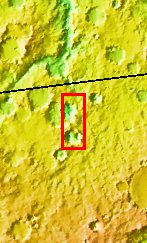
Context image for PIA09465
Not Quite RoundThe two craters in this image are not circular, but instead are more diamond-shaped. Meteor Crater in Arizona is also more square than round. Meteor Crater formed in a limestone rock that had already been faulted in two directions. The preexisting faults controlled some of the stress induced by the impacting event, resulting in the crater not ending up perfectly round. The same thing likely occurred with the formation of the 20070823a.pngmartian craters -- a preexisting fault or fracture system in the rocks.
Image information: VIS instrument. Latitude -20.6N, Longitude 161.5E. 17 meter/pixel resolution.
Please see the THEMIS Data Citation Note for details on crediting THEMIS images.
Note: this THEMIS visual image has not been radiometrically nor geometrically calibrated for this preliminary release. An empirical correction has been performed to remove instrumental effects. A linear shift has been applied in the cross-track and down-track direction to approximate spacecraft and planetary motion. Fully calibrated and geometrically projected images will be released through the Planetary Data System in accordance with Project policies at a later time.
NASA's Jet Propulsion Laboratory manages the 2001 Mars Odyssey mission for NASA's Office of Space Science, Washington, D.C. The Thermal Emission Imaging System (THEMIS) was developed by Arizona State University, Tempe, in collaboration with Raytheon Santa Barbara Remote Sensing. The THEMIS investigation is led by Dr. Philip Christensen at Arizona State University. Lockheed Martin Astronautics, Denver, is the prime contractor for the Odyssey project, and developed and built the orbiter. Mission operations are conducted jointly from Lockheed Martin and from JPL, a division of the California Institute of Technology in Pasadena.

